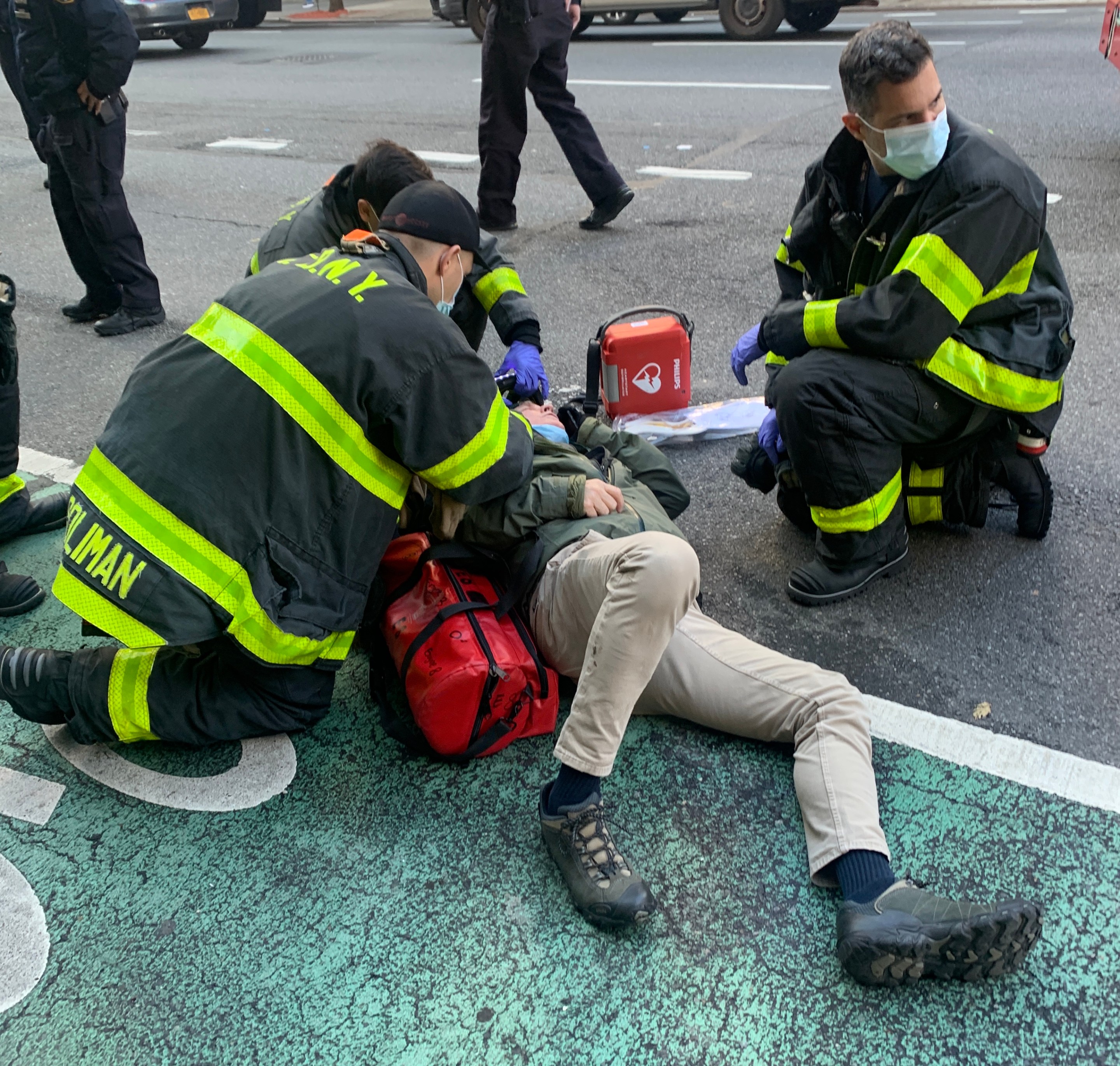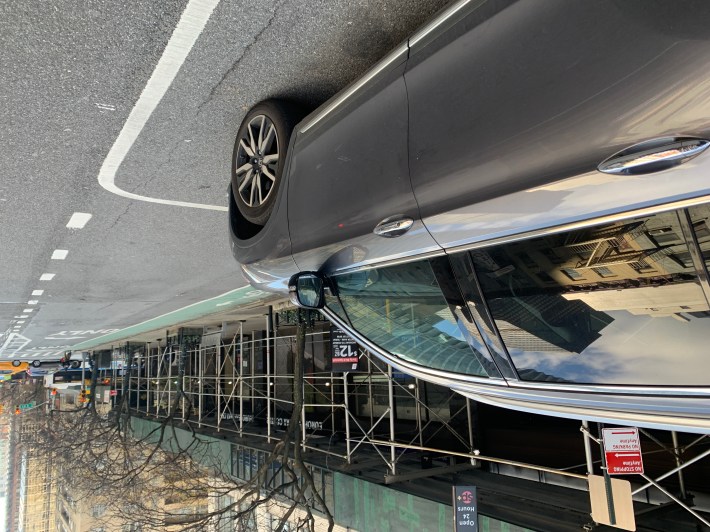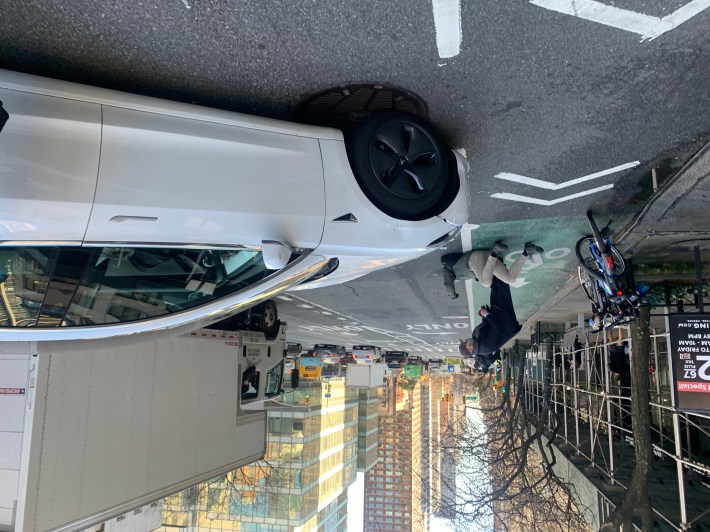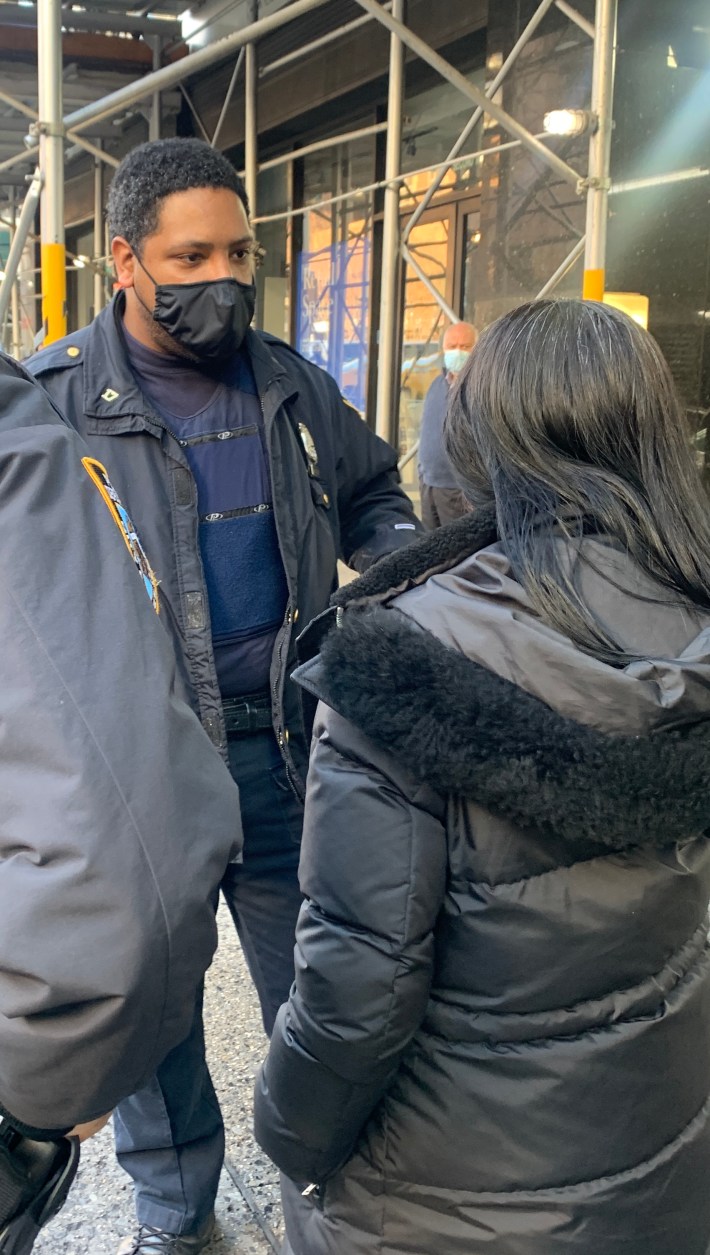ANATOMY OF A CRASH: Cyclist Badly Injured by Driver, Yet Cops Do Nothing
1:59 PM EST on December 10, 2020

The victim being treated after a horrific, scary crash on Second Avenue on Thursday.

The driver badly injured a cyclist — and drove off scot free.
It all happened on the Second Avenue protected bike lane this morning — a crash that was much like 120 or so injury-causing car crashes that occur on average every day in this city. Despite (or, let's be clear, because of) the fact that this kind of thing happens every day, it's worth reviewing everything that transpired, especially since it is rare for a reporter to witness the sequence of events from the seconds before the crash to about an hour after, when, in this case, the driver was allowed to hop back into her Tesla and go about her day without so much as a summons for badly injuring a cyclist, who might easily have died if he had fallen a different way.
It all started at 9:56 a.m. I was heading down the Second Avenue protected bike lane and had passed through the "pork chop" at the 59th Street Bridge. That infrastructure improvement, made by the Department of Transportation in 2019, helps keep cyclists and drivers apart, but it has become very crowded as bike riders must wait through two light cycles. As a result, many gather on the cement island until the light changes, whereupon they have to return to single-file cycling in the protected bike lane, which is too narrow to accommodate their numbers.
There were two cyclists in front of me — one hugging the curb, the other passing him on the right on an electric Citi Bike. Now, here's what that stretch of lane looks like:

That's my bike with the fluorescent fenders in the buffered section. The two cyclists were inside the painted bike lane at the time of the crash. The driver of the white Tesla (parked in the garage driveway to the left when this photo was taken) was turning into the parking garage just ahead of where my bike is seen in the photo.
Also note the car with the MD 1323 plates. It is illegally parked (see the "No parking anytime" sign in the picture). I checked the windshield and, sure enough, there was a placard reading "Surgeon" that was allegedly issued by the New York State Troopers PBA (the union did not respond to a request for comment, nor did the "surgeon," on whose car I left a note). The spot should have had some marking, paint or bollards to indicate that it is not a legal parking space, but the DOT has not done the work. (A business owner on the block told me that same surgeon's car is parked in that space "all the time." "There's no emergency!" he added. I ran the plate: 28 parking tickets.)
As a result of the placement of the car, this is what the Tesla driver saw in the instant before the crash:

Back to the timeline: The cyclist who had been on the right had just about overtaken the other cyclist when the driver slammed into him. She was not going at excessive speed, but she did not pause as she made the left turn into the parking lot and struck the cyclist with her right front fender. His Citi Bike was knocked to the curb, but his momentum carried him over the Tesla's hood, and he flipped over, landing on his helmeted head.
I was just behind him and stopped to call 911 before even going to where he was writhing on the pavement. Here is a photo of the scene (after I called 911). You can also see the dent in the Tesla's fender:

He screamed in agony for about a full minute, but I and another witness calmed him by telling him help was on the way and by helping him call his partner to alert her that he had been injured in a crash. EMTs arrived quickly — not more than four minutes.

We learned the victim's name is Mike. He said he was in extreme pain in his lungs and back. He could move all his limbs — a good sign, I was later told — but EMTs put him in a neck brace and loaded him into the ambulance. He was off the street and being treated in the ambulance before police arrived.
That's a key detail because at one point, four squad cars and six officers were on the scene. But the officer leading the investigation — his nameplate identified him as "McCloud" — spoke to the driver at length and never spoke to the victim. I and another witness mentioned to McCloud that we had seen the entire thing, but he did not conduct an investigation with any real diligence (in fairness, it was pretty obvious what had transpired and no one was disputing the chain of events). He spoke to the driver, who told him that she "never saw" the cyclist as she made her turn, yet McCloud showed no interest at all when I and a third witness alerted him to the illegally parked placarded surgeon's car, which clearly should have been ticketed.
McCloud did briefly talk to the other witness, who later told me that the officer was merely seeking to confirm his overall impression of the crash: that the driver did, in fact, strike the cyclist in the bike lane by cutting him off.
I was certain, given what the witness told me, that the driver would be issued a ticket for failing to yield to the cyclist or for failing to exercise due care. Such tickets are the low-hanging fruit of traffic enforcement, but they do, at the very least, make the driver accountable for her actions and could add three points to her license — a light punishment, but one, nonetheless, that could lead to a license suspension if the driver reaches 11 points in any 18-month period. (I checked her plate against the city's camera issued ticket database and found one speeding ticket from last month; it is unclear when the car was purchased, but it appeared to be new. Had a police officer issued the ticket instead of a camera, it would have meant another three points at least on the license.)
The witness seemed satisfied and he pedaled off. I waited to see if McCloud would, indeed, issue a ticket.
He did not.
Then I saw the driver motor away.
And then I saw McCloud motoring away, so I chased him down to the next traffic light to question him, poking my masked face into the patrol car.
"With all due respect, officer, why did you not issue a failure-to-yield ticket? It's basic," I asked. I reminded him that I had witnessed the entire thing, yet he did not ask me what had happened.
"I know what happened and decided against a failure-to-yield ticket," McCloud said. "It was just an accident. She didn't see him."
"Officer, again, with all due respect, if she 'didn't see him,' that's exactly when you should be writing a summons for failure to yield," I said, still out of breath from chasing him (though likely also from the adrenaline of having witnessed the crash and the subsequent police inaction). "It is the drivers responsibility to yield to pedestrians and cyclists. She turned directly into him."
"It was an accident," McCloud repeated.
It was an accident.
Something about those words — ringing in my ears the way Mike's screams had echoed an hour earlier, the way my own screams have echoed when I myself have been hit by drivers claiming it was "just an accident" — made me outraged. Something in McCloud's tone certainly, but something also infuriated me about the belief of the officer that this was just another shoulder shrug and "whaddya gonna do?" from a public servant with a windshield perspective. Nonetheless, I withdrew from the patrol car window before I said some things that would be misinterpreted as obstruction of governmental operation.
In my years at Streetsblog, I have frequently questioned the mayor and various police commissioners about why officers don't write failure-to-yield consistently, and I have been consistently told that officers have discretion to write the tickets based on their interpretation of the events. And I have consistently told those mayors and police commissioners that this "discretion" is sometimes biased due to an officer's own experience as a driver (51 percent of police officers live in the suburbs — which rises far higher if you include Staten Island) or limited sympathies for people who get around by bike (suburban residents love to yell "Get a car!" to cyclists who are just trying to get from Point A to Point B).
McCloud certainly revealed his own windshield perspective, but it's a perspective that too many officers share. Last year, from Jan. 1 through and Oct. 31, NYPD officers wrote 63,955 tickets to drivers for failing to yield, which sounds like a lot, but it is fewer than three per precinct per day. This year over the same period, that number has dropped to 30,875 — a more than 50-percent drop, and roughly one failure-to-yield ticket per precinct per day. (You might be inclined to say it's due to a drop in driving during the pandemic, but more cyclists have been injured this year than last, and more motorists have been killed this year, too, so the danger on the road still exists at a horrifying high level.)
I'm not saying that a failure-to-yield ticket in this case is going to suddenly make the roads safe for cyclists and pedestrians. But it is clear that the first step is a police force that understands that reckless drivers must be held accountable — and the officers themselves must see reckless driving as a danger to the public deserving of their best efforts.
I did not see that on Thursday morning.
Gersh Kuntzman is editor in chief of Streetsblog NYC and Streetsblog USA. He also writes the Cycle of Rage column, which is archived here.
Stay in touch
Sign up for our free newsletter
More from Streetsblog New York City
Justice Dept., Citing Streetsblog Reporting, Threatens to Sue NYPD Over Cops’ Sidewalk Parking
The city is now facing a major civil rights suit from the Biden Administration if it doesn't eliminate illegal parking by cops and other city workers.
What to Say When Someone Claims ‘No One Bikes or Walks in Bad Weather’
Yes, sustainable modes are more vulnerable to bad weather. But that's why we should invest more in them — not less.
NYC Transit’s New Operations Planning Chief Wants To Fight ‘Ghost Buses’
One-time transit advocate and current MTA Paratransit VP Chris Pangilinan will oversee bus and subway operations for the whole city.
Friday’s Headlines: Gimme Bus Shelter Edition
The days of the Landmarks Preservation Commission reviewing every proposed bus shelter in landmarked districts may be no more. Plus more news.
Deal Reached: Hochul Says ‘Sammy’s Law’ Will Pass
The bill, though imperfect, has been four years in the making.




